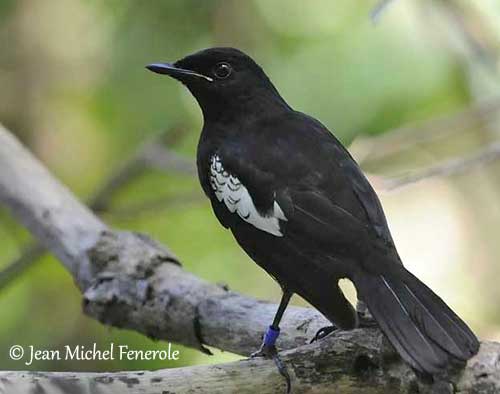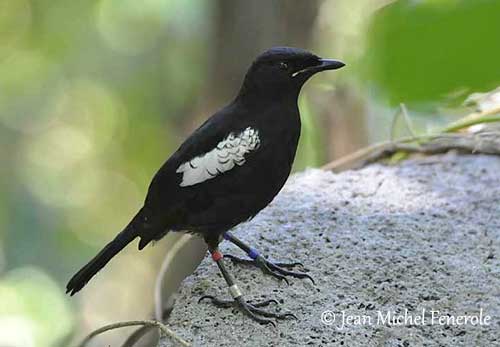
REPRODUCTION OF THIS SPECIES:
The Seychelles Magpie-Robin can breed year-round if food is available, with peak during heavy rainfall, between November and March.
The female builds the nest with some help from the male. The cup-shaped nest is made with small twigs, dry grasses and coconut fibres. It is often placed in hole in tree trunk or in the crown of coconut palm. This species may also use nest-boxes.
The female lays a single (rarely two) white or pale blue egg with dark markings. She incubates during 16-22 days. The chick is fed by both adults and fledges 16-22 days after hatching. It is a very poor flier and vulnerable to predation.
It is able to forage itself, but both adults feed it for 5-18 weeks. Most of young birds remain within their parental territory for several months.
PROTECTION / THREATS / STATUS:
The Seychelles Magpie-Robin is a restricted-range species, but following important conservation measures and recovery programme, the species has slowly increasing populations on several islands.
Introduced predators such as cats and rats have been eradicated, whereas Barn Owl and Common Myna are under control.
Habitat creation, supplementary food, nest-boxes, protection of nests and predator control involved population increase. In 2015, it was estimated to number 283 individuals, equating to 190 mature individuals.
But currently, the Seychelles Magpie-Robin is listed as Endangered.
Fr: Shama des Seychelles
Ang: Seychelles Magpie-Robin
All: Seychellendajal
Esp: Shama de Seychelles
Ita: Pettirosso gazza delle Seychelles
Nd: Seychellenlijster
Sd: seychellshama
Photographer:
Jean Michel Fenerole
Photos d’Oiseaux du monde
Text by Nicole Bouglouan
Sources:
HANDBOOK OF THE BIRDS OF THE WORLD Vol 10 by Josep del Hoyo-Andrew Elliott-David Christie - Lynx Edicions - ISBN: 8487334725
Birds of Madagascar and the Indian Ocean Islands Par Roger Safford, Adrian Skerrett, Frank Hawkins – ISBN: 1472924118, 9781472924117- Editeur: Bloomsbury Publishing, 2015
Birds of Seychelles – By Adrian Skerrett and Tony Disley – Editeur: A&C Black, 2013 – ISBN: 140818124X, 9781408181249 – 176 pages
Robins and Chats Par Peter Clement - Helm Identification Guides – Editeur : Bloomsbury Publishing, 2016 – ISBN: 1408155974, 9781408155974 - 688 pages
Aqua-Firma – Water – Wilderness – Wildlife
Fondation Tany Meva - Seychelles Magpie-robin emergency response project
WAZA - Seychelles Magpie-Robin
Seychelles Magpie-Robin
Copsychus sechellarum
Passeriformes Order – Muscicapidae Family
INTRODUCTION:
The Seychelles Magpie-Robin is endemic to Seychelles Islands where it occurs on some islands. The species was formerly more widespread, but its disappearance is closely related to introduction of predators such as cats and rats, human persecution and habitat conversion.
A recovery programme supported by Seychelles Government, BirdLife International and the RSPB (Royal Society for the Protection of Birds) including creation of habitat, supplementary feeding, provision of nest-boxes and control of Common Myna has involved the establishment of new populations.
The Seychelles Magpie-Robin is now present on some Seychelles islands, with a larger population on Frégate. But the species is currently listed as Endangered.
DESCRIPTION OF THE BIRD:
Biometrics:
Length: 18-20 cm
Weight: M: 77 g – F: 65 g
The Seychelles Magpie-Robin has glossy blue-black plumage overall, except for conspicuous white wing patch visible like a broad white bar on folded wing. The bluish sheen is well seen in good light. The square-tipped tail is fairly long.
On the black head, there are erectile feathering on lores, forehead and throat.
The robust bill is black. The eyes are dark brown. Long legs and feet are black.
Male and female are similar.
The juvenile/immature resembles adult, but the white wing patch shows diffuse black marks and the plumage is less glossy.

RANGE:
The Seychelles Magpie-Robin occurs mainly on Frégate. The species has been introduced on Cousin, Cousine, Aride and Denis for conservation purposes.
HABITAT:
The Seychelles Magpie-Robin was formerly a species of mature coastal forest, but now, it frequents mostly plantations and gardens, tracks and open areas around houses. It can be seen in mature woodland in upper central areas of the islands.
CALLS AND SONGS:
The call of the Seychelles Magpie-Robin is a loud, ascending whistle “weeh weeh weeh” usually given in alarm, but a softer version of three notes is uttered towards intruders. During nest-defence, we can hear some nasal “cherr” when attacking predators.
The song is a series of melodious warbles interspersed with harsher phrases. Some mimicry is sometimes included. The female has simpler song, occasionally given in duet with the male “weeh werh whoo”.
BEHAVIOUR IN THE WILD:
The Seychelles Magpie-Robin has terrestrial feeding habits. It feeds on small invertebrates and fruit. Its preferred food is insect larvae.
Its diet includes various small to medium-sized insects, but also spiders, scorpions and earthworms. It also takes small vertebrates such as geckos, frogs, young mice and young snakes. It feeds on small fish dropped by the tree-nesting White Tern, eggs of seabirds and small crabs.
The Seychelles Magpie-Robin catches insects from leaves. It hops on the ground and turns over the leaf litter to disturb prey. It also consumes fruits including figs, coconut, mango, cashew and pawpaw.
The Seychelles Magpie-Robin is monogamous and territorial during the breeding season. It can breed year-round if food is available. It nests in tree-hole or coconut crown, but it may use nest-boxes too.
The male sings at dawn and dusk from treetops or other exposed perches. During the displays, it stretches the neck upwards while the wings are drooped or half-opened in order to display the white wing patches. The tail is lowered.
It also chases the female in flight, and she responds by fluffing out the feathers of her flanks.
The Seychelles Magpie-Robin is sedentary. It may disperse to other islands over distances of up to 45 kilometres.
The flight is direct and slightly undulating.
